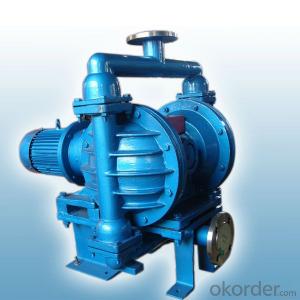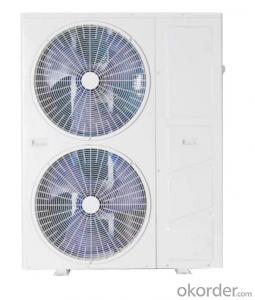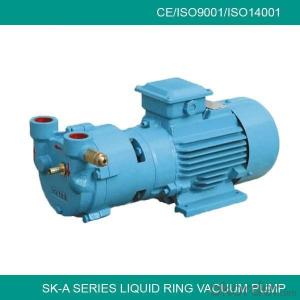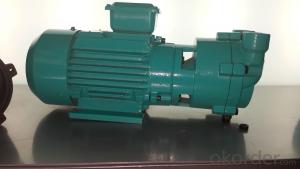Vacuum Pumps SKA
- Loading Port:
- China Main Port
- Payment Terms:
- TT OR LC
- Min Order Qty:
- -
- Supply Capability:
- -
OKorder Service Pledge
Quality Product, Order Online Tracking, Timely Delivery
OKorder Financial Service
Credit Rating, Credit Services, Credit Purchasing
You Might Also Like
Based on SK series, is designed specially for the use of plastics industry. Therefore, many problems have been solved, for instance: incapability to work continuously, in case of sufficient wafter to be draw-out, dirts is resulted from sewage, impossibility to restart work after long pause. It is widely used in Tubing and Molding machinery.Items:SK-0.15A、SK-0.3A、SK-0.5A、SK-0.8A、SK-1.2A、SK-2A、SK-3A,Motor power:0.55~5.5KW,extract capacity :0.15~3(m3/min),Limit vacuum:-0.095MPa.
List of size performance
Type | electric machine power (kw) | off-gas quickresult (m3/min) | limit vacuum (Mpa) | caliber entering or excludinggas (inch) | weight (kg) | size(L×W×H) (mm) |
SK-0.15A | 0.55 | 0.15 | -0.095 | G3/4" | 14 | 380×170×220 |
SK-0.3A | 1.1 | 0.3 | -0.095 | G1" | 33 | 460×180×235 |
SK-0.5A | 1.5 | 0.5 | -0.095 | G1" | 34 | 485×180×235 |
SK-0.8A | 2.2 | 0.8 | -0.095 | G1" | 37 | 480×185×235 |
SK-1.2A | 3.0 | 1.2 | -0.095 | G1 1/2" | 51.5 | 530×220×260 |
SK-2A | 4.0 | 2.0 | -0.095 | G1 1/2" | 63 | 560×220×285 |
SK-3A | 5.5 | 3.0 | -0.095 | G2" | 105 | 645×310×325 |
■List of installation
Type | L | L1 | L2 | A | B | B2 | B3 | H | H2 | 2-d | 4-Φ | s |
SK-0.15A | 381 | 157 | 100 | 90 | 170 | 125 | 160 | 175 | 217 | G3/4" | 10 | G1/2" |
SK-0.3A | 460 | 205 | 125 | 110 | 180 | 140 | 177 | 194 | 235 | G1" | 10 | |
SK-0.5A | 485 | 228 | 125 | 110 | 180 | 140 | 177 | 194 | 235 | G1" | 10 | |
SK-0.8A | 480 | 223 | 125 | 80 | 185 | 140 | 177 | 194 | 235 | G1" | 10 | |
SK-1.2A | 528 | 240 | 140 | 110 | 218 | 160 | 197 | 213 | 260 | G1 1/2" | 12 | |
SK-2A | 560 | 265 | 140 | 110 | 220 | 190 | 234 | 234 | 286 | G1 1/2" | 12 | |
SK-3A | 645 | 305 | 140 | 150 | 310 | 216 | 272 | 327 | 323 | G2" | 12 |
- Q: Can an air pump be used for inflating sports balls like basketballs and soccer balls?
- Certainly, sports balls such as basketballs and soccer balls can be inflated using an air pump. In truth, it is the prevailing and suggested approach for inflating these particular balls. Generally, air pumps are equipped with diverse adapters tailored to fit the various valve systems found on basketballs and soccer balls. This facilitates effortless and effective inflation, allowing the balls to reach the desired pressure. Air pumps are specifically designed to deliver a consistent flow of air, thereby simplifying the inflation procedure and guaranteeing that the ball is adequately inflated for optimal performance.
- Q: Are there air pumps suitable for medical use?
- Yes, there are air pumps specifically designed and suitable for medical use. These air pumps are often used for medical devices such as compression stockings, inflatable splints, or air mattresses for patients with limited mobility or who require pressure relief.
- Q: Can an air pump be used for inflating air loungers with built-in coolers?
- Yes, an air pump can be used for inflating air loungers with built-in coolers. The air pump provides the necessary pressure and airflow to inflate the air chambers of the lounger, including the built-in cooler section.
- Q: Are air pumps suitable for inflating air pillows for travel?
- Indeed, air pumps can be utilized to inflate air pillows designated for travel purposes. These air pillows are specifically crafted to offer comfort and assistance throughout one's journey, and employing an air pump guarantees their inflation to the desired level of firmness. Depending on personal choice and convenience, one may opt for either manual air pumps or electric ones. Thanks to air pumps, the inflation of air pillows becomes a swift and effortless process, enabling travelers to embark upon a relaxed and peaceful voyage.
- Q: How long does an air pump take to deflate an inflatable object?
- The length of time it takes for an air pump to deflate an inflatable object can vary depending on several factors. The size and volume of the object, the power and efficiency of the air pump, and the pressure of the air inside the inflatable can all play a role in the deflation process. Generally, a standard air pump can deflate a small to medium-sized inflatable object within a few minutes. However, larger or more complex inflatables may take longer, potentially up to 10-15 minutes or even more. Additionally, the rate at which the air is released from the inflatable can also affect the deflation time. Some air pumps have adjustable settings or different nozzles that control the airflow, allowing for faster or slower deflation. It's worth noting that manually deflating an inflatable object using an air pump may take longer than using an electric or high-powered pump. The method chosen to deflate the object will also impact the time it takes. Ultimately, the specific circumstances and equipment used will determine the exact duration it takes for an air pump to deflate an inflatable object.
- Q: Open oxygen pump goldfish why are you always floating in the water floating a few days and then died. What is what is the treatment to prevent it
- Hypoxia is indeed the symptoms, there will be oxygen hypoxia, it is likely to lead to excessive nitrite poisoning, hypoxia, which is similar to human gas poisoning the same reason, and finally hypoxia. The reason for this is the deterioration of the water quality. It is necessary to strengthen the filtration and properly change the trapped water. The water is good and the fish is all right.
- Q: How does an air pump prevent overheating in fish tanks?
- An air pump prevents overheating in fish tanks by improving water circulation and oxygenation. The constant flow of air bubbles created by the air pump agitates the water surface, facilitating the exchange of gases, which helps to cool down the temperature in the tank.
- Q: Can an air pump be used for air pollution control systems?
- Yes, an air pump can be used for air pollution control systems. Air pumps are often used in air pollution control systems to help remove pollutants from the air by creating air flow or suction.
- Q: How to choose the right size air pump for a specific application?
- To choose the right size air pump for a specific application, you need to consider the airflow requirements of the application and match it with the capacity of the air pump. Calculate the required airflow by determining the volume of air needed to achieve the desired results. Then, compare this airflow requirement with the specifications of different air pumps available in the market. Select an air pump with a capacity that meets or exceeds the calculated airflow requirement to ensure optimal performance and efficiency for the specific application.
- Q: What is the maximum distance an air pump can push air?
- The maximum distance an air pump can push air depends on various factors such as the power and design of the pump, the pressure it can generate, and the resistance it encounters in the system it is connected to. Generally, air pumps are designed to push air within a relatively short distance, typically within a few feet or meters. For example, a typical handheld air pump used for inflating tires or sports equipment may be able to push air for several feet, allowing for inflation within a close range. However, if you try to push air through a longer distance using such a pump, the pressure and force would decrease significantly, resulting in limited effectiveness. On the other hand, industrial-grade air pumps or compressors can generate higher pressures and are capable of pushing air over longer distances. These powerful pumps are often used in applications such as pneumatic systems, HVAC systems, or large-scale industrial operations. The maximum distance they can push air varies depending on their specifications and the specific requirements of the system they are connected to. In conclusion, the maximum distance an air pump can push air is not a fixed value but rather depends on the type, power, and design of the pump, as well as the resistance it encounters. It is important to choose the right pump for the intended application and consult the manufacturer's specifications for optimal performance.
Send your message to us
Vacuum Pumps SKA
- Loading Port:
- China Main Port
- Payment Terms:
- TT OR LC
- Min Order Qty:
- -
- Supply Capability:
- -
OKorder Service Pledge
Quality Product, Order Online Tracking, Timely Delivery
OKorder Financial Service
Credit Rating, Credit Services, Credit Purchasing
Similar products
Hot products
Hot Searches
Related keywords
























